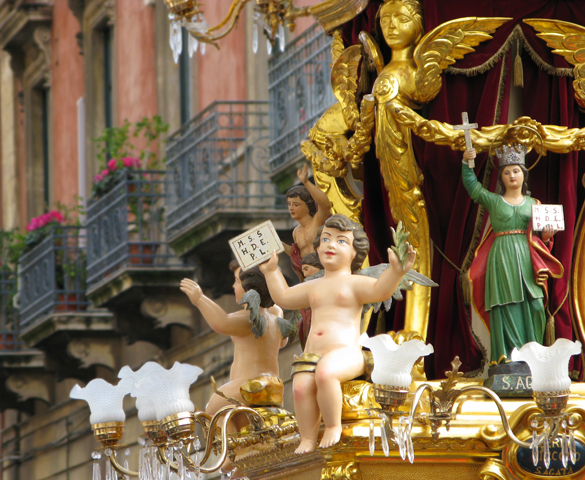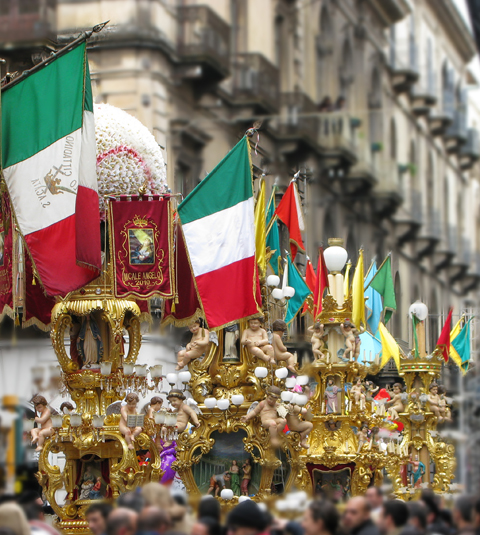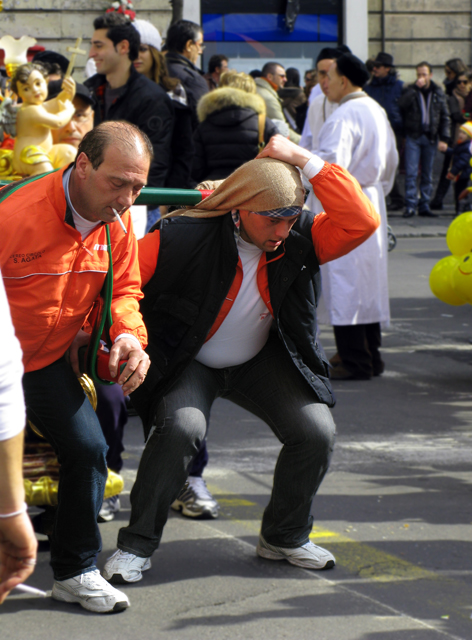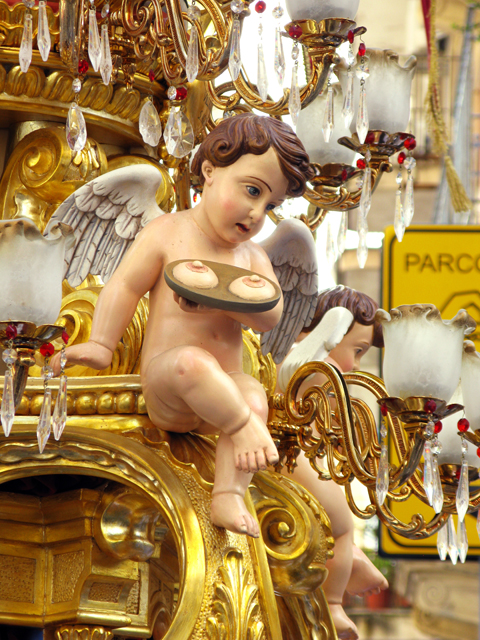Catania is under siege. Every half hour or so there are more explosions. The sound booms around the city, always from a slightly different direction as the action moves from street to street. For a change, however, this isn’t anything ominous. It’s the Festival of Sant’Agata, and the explosions aren’t guns or cannons, but fireworks.
 Sant’Agata was a Christian at a time when it wasn’t great to be such. When she was approached by a lowborn Roman asking for her hand in marriage, she refused on grounds of her faith. Quintianus, the Roman in question, then turned nasty. Agata was imprisoned and tortured – including having her breasts first mutilated and then cut off – before being sentenced to death by being rolled naked on hot coals. Unsurprisingly she died in prison on the 5th of February in the year 251. Her cult, however, lives on to this day, and her remains are kept in Catania’s cathedral. Except for on the 4th and 5th of February, when she is paraded around the city.
Sant’Agata was a Christian at a time when it wasn’t great to be such. When she was approached by a lowborn Roman asking for her hand in marriage, she refused on grounds of her faith. Quintianus, the Roman in question, then turned nasty. Agata was imprisoned and tortured – including having her breasts first mutilated and then cut off – before being sentenced to death by being rolled naked on hot coals. Unsurprisingly she died in prison on the 5th of February in the year 251. Her cult, however, lives on to this day, and her remains are kept in Catania’s cathedral. Except for on the 4th and 5th of February, when she is paraded around the city.
Grabbing my camera I head out in search of her. Carried on a silver bier pulled by hordes of white-clothed men, she’s slow-moving and likely to be surrounded by crowds. I know she got going on her journey at 7am, because that’s when the fireworks started. It’s now coming up to 11, so I confidently head for Piazza Stesicoro, about halfway around the circuit. The streets are quiet. Ominously so. I wander for nearly an hour before, despondent, turning back towards home. I’ve missed her.
As I reach Via Umberto, I see a man walking towards me, dressed all in white apart from a black velvet cap. Absently I note that he looks like a butcher. Then I see two more men in a car, again dressed in white. Then some more, walking on the road. These ones, I notice, have white gloves and handkerchiefs tucked into their white rope belts. The realisation filters into my brain that they’re not butchers: they’re Sant’Agata’s followers. The devoti, as they are called, dress like this for the Festival to symbolise purity and humility. Ironically, given that Agata is such an icon of female suppression, until recently the devoti were made up exclusively of men. Traditionally women wear green tunics, not white. In recent years, however, this has changed, and I see lots of young women in the white garb as I carry on walking.
Despite the fact that there are lots of devoti in the streets, there is still no sign of Agata herself. I’ve almost given up. However, 5 minutes from home I see the procession. I’d been hopelessly optimistic in the speed that it would travel and had overshot them by a good half mile. I stand at the top of road and look down the hill. There are floats coming towards me, but they’re moving very strangely. They bob up and down, and every so often they veer off to the right or left. They also stop every few hundred yards. Intrigued, I walk closer. Opportunistic balloon sellers and mobile candy-floss makers stream past me, getting ahead of the procession before the main event comes up the road and distracts people from their wares. There’s a scent of candied sugar in the air and an excited buzz of conversation all around me. Getting close enough to see the first float I realise that these aren’t floats at all. They’re certainly big enough, but first of all they resemble giant candlesticks, and secondly, unbelievably, their movement is completely and utterly *manpowered*.
The candlesticks are known as i cannalori. There is one for each guild in Catania: the fish-sellers, the butchers, the greengrocers and so on – eleven in total. Each is decorated slightly differently, but they all serve a similar function. As they walk the route, they stop at shops and bars to offer a blessing for the coming year. Not every cannaloro stops at every shop, and I’m unsure how this is decided until I overhear a conversation next to me. Yeah, it’s paid for. The cynical side of me suspects there is more than just spiritual protection at work here.
 Squashing (with difficulty) my snarky inner monologue, I look closer at the cannalori themselves. Each one is a good 12 to 15 foot high and set on a solid marble base, green-veined and criminally heavy. The main structures are made of gilt-covered wood, carved with images of Sant’Agata, draped with flags and topped with enormous floral heads. Hefting these behemoths are eight men: three ranged across the front, three across the back, and two at each side. The man at centre front is the leader, dictating the movement and pace. The four at the corners, meanwhile, are the heavy workhorses. The cross beams of the candlesticks rest across their shoulders. They puff along the street red-faced, sweating and straining, heads covered with hessian sacks. Unlike the devoti, however, this has nothing to do with symbolism and everything to do with saving their skin. Along the back of the sack is a large padded section, which sits over the base of their necks to take some of the strain. There may be eight men carrying these beasts, but each candlestick can weigh up to 1500lbs. Fifteen. Hundred. Pounds. Or, if you prefer the metric system, 680kg. Divided by eight, that’s still 180lbs (nearly 13 stone), or 85kg each. There are going to be some seriously aching backs in the morning.
Squashing (with difficulty) my snarky inner monologue, I look closer at the cannalori themselves. Each one is a good 12 to 15 foot high and set on a solid marble base, green-veined and criminally heavy. The main structures are made of gilt-covered wood, carved with images of Sant’Agata, draped with flags and topped with enormous floral heads. Hefting these behemoths are eight men: three ranged across the front, three across the back, and two at each side. The man at centre front is the leader, dictating the movement and pace. The four at the corners, meanwhile, are the heavy workhorses. The cross beams of the candlesticks rest across their shoulders. They puff along the street red-faced, sweating and straining, heads covered with hessian sacks. Unlike the devoti, however, this has nothing to do with symbolism and everything to do with saving their skin. Along the back of the sack is a large padded section, which sits over the base of their necks to take some of the strain. There may be eight men carrying these beasts, but each candlestick can weigh up to 1500lbs. Fifteen. Hundred. Pounds. Or, if you prefer the metric system, 680kg. Divided by eight, that’s still 180lbs (nearly 13 stone), or 85kg each. There are going to be some seriously aching backs in the morning.
 I watch in fascination as the leader of the bakers’ canneloro readies to move. They’ve stopped for a rest, facing up the road, but they need to turn to give grace to a bar. The eight men position themselves under the cross beams, squatting like weightlifters. At the leader’s signal they heave themselves upright and perform a little shuffling sidestep. Step, together, step, together. The men at the front do this on the spot, while the ones at the back move to their right. Slowly, the candlestick bobs and sways, turning 90 degrees until it faces the open door of the bar. The owner lounges against the doorframe, laughing and smiling at the honour he is about to receive. The men carrying the cannaloro stagger forward until the front man is close enough for the owner to touch. Something is said – I’m not close enough to hear, but it seems to be a form recitation. The candlebearers reverse. Step, together, step. Back into the road, where they put down their heavy load with relief. The crowd ebbs and flows around them, and the photographers in the melée, including me, take their opportunity to snap pictures. The leader puts a cigarette into his mouth but doesn’t light it. It just stays there as a dangling placebo. One of his team is not so reticent. Leaning up against the cannaloro he sparks his lighter and draws smoke into his lungs as he pulls his hessian sack off his head. Underneath is a blue and white bandanna, jauntily knotted at the base of his neck. He looks like a modern-day pirate.
I watch in fascination as the leader of the bakers’ canneloro readies to move. They’ve stopped for a rest, facing up the road, but they need to turn to give grace to a bar. The eight men position themselves under the cross beams, squatting like weightlifters. At the leader’s signal they heave themselves upright and perform a little shuffling sidestep. Step, together, step, together. The men at the front do this on the spot, while the ones at the back move to their right. Slowly, the candlestick bobs and sways, turning 90 degrees until it faces the open door of the bar. The owner lounges against the doorframe, laughing and smiling at the honour he is about to receive. The men carrying the cannaloro stagger forward until the front man is close enough for the owner to touch. Something is said – I’m not close enough to hear, but it seems to be a form recitation. The candlebearers reverse. Step, together, step. Back into the road, where they put down their heavy load with relief. The crowd ebbs and flows around them, and the photographers in the melée, including me, take their opportunity to snap pictures. The leader puts a cigarette into his mouth but doesn’t light it. It just stays there as a dangling placebo. One of his team is not so reticent. Leaning up against the cannaloro he sparks his lighter and draws smoke into his lungs as he pulls his hessian sack off his head. Underneath is a blue and white bandanna, jauntily knotted at the base of his neck. He looks like a modern-day pirate.
Two minutes later, the cigarette is finished and it’s time to move on. A community policeman bustles forward, whistle at the ready. The candlebearers assume the position and take up the strain, heaving their load up off the ground again. Faces taut with concentration and veins popping from their foreheads, they do the step, together, step thing again, this time with the front men rotating. Then they’re off. The policeman strides ahead of them, blowing his whistle and waving people out of the way. Once these things get going the momentum carries them forward for a good hundred yards, and there’s no possibility of stopping for idiots in the road.
 I watch all eleven cannalori process slowly along Via Umberto, noting the differences in decorations. Some are older than others, bearing pennants embroidered with dates fifty years in the past. What they all have in common, however, is the fact that they are covered with cherubs, delicately painted, often bearing platters. Looking closer at one of them I realise that on the platter is a pair of dismembered breasts. The contrast between the sweet-faced chubby angel and its macabre offering is shocking. Looking around me as the cannalori disappear into the distance I note another – less startling, but equally poignant – juxtaposition. There are still plenty of people milling about dressed in devoti clothing. However, most of them have hitched up their tunics and tucked them into their jean pockets. Some have bomber jackets over the top and all have scarves draped with effortless Italian cool around their necks. Some of these are white, but many more are not. People saunter into bars and shops, and light up cigarettes. A few go into the betting shop to watch the football. The Saint may be out and about this weekend, but she isn’t going to disturb anyone’s routine too much.
I watch all eleven cannalori process slowly along Via Umberto, noting the differences in decorations. Some are older than others, bearing pennants embroidered with dates fifty years in the past. What they all have in common, however, is the fact that they are covered with cherubs, delicately painted, often bearing platters. Looking closer at one of them I realise that on the platter is a pair of dismembered breasts. The contrast between the sweet-faced chubby angel and its macabre offering is shocking. Looking around me as the cannalori disappear into the distance I note another – less startling, but equally poignant – juxtaposition. There are still plenty of people milling about dressed in devoti clothing. However, most of them have hitched up their tunics and tucked them into their jean pockets. Some have bomber jackets over the top and all have scarves draped with effortless Italian cool around their necks. Some of these are white, but many more are not. People saunter into bars and shops, and light up cigarettes. A few go into the betting shop to watch the football. The Saint may be out and about this weekend, but she isn’t going to disturb anyone’s routine too much.
I take my cue from the Italians and head home for lunch.







Pingback: The Twelve Months of Twenty-Twelve » Driving Like a Maniac